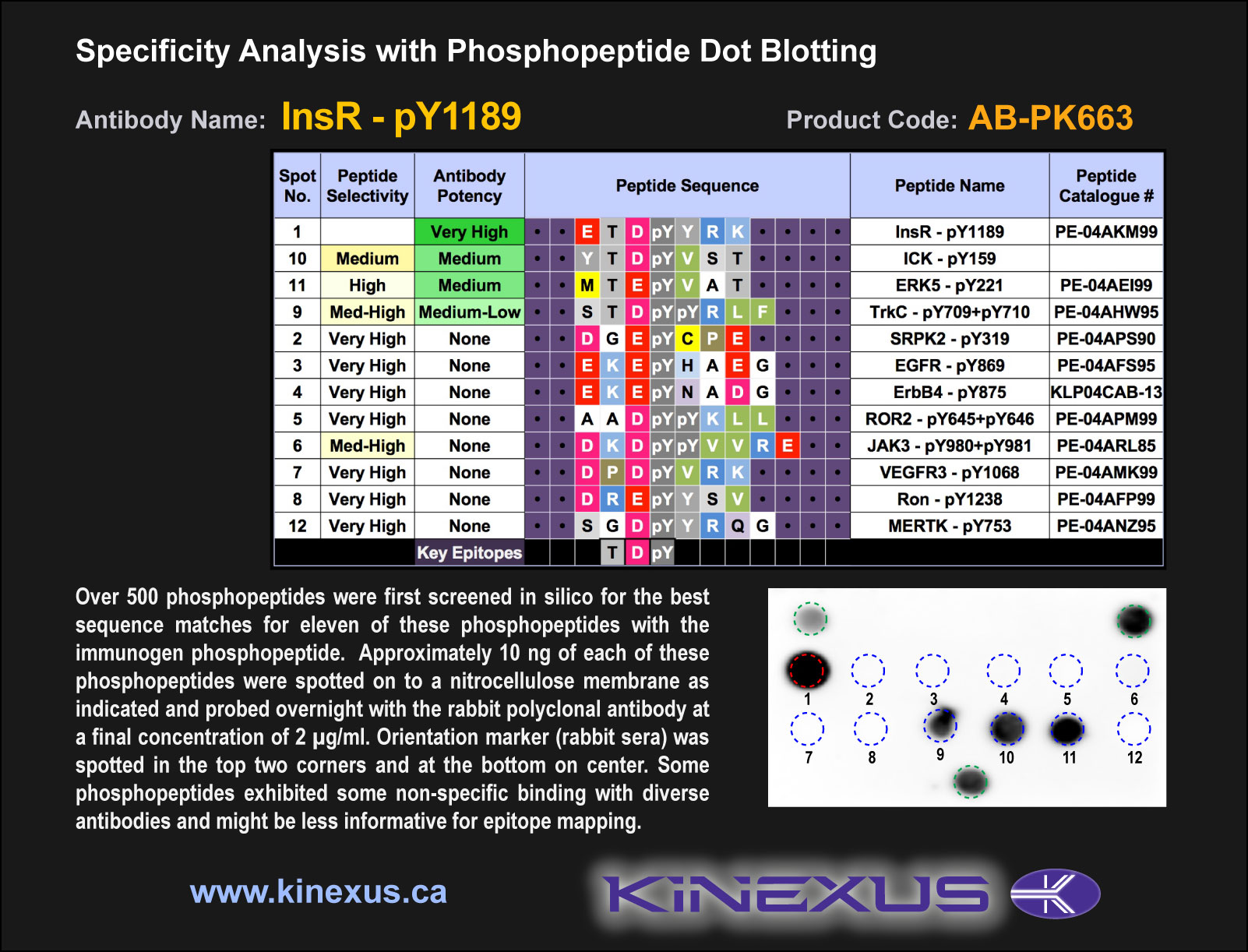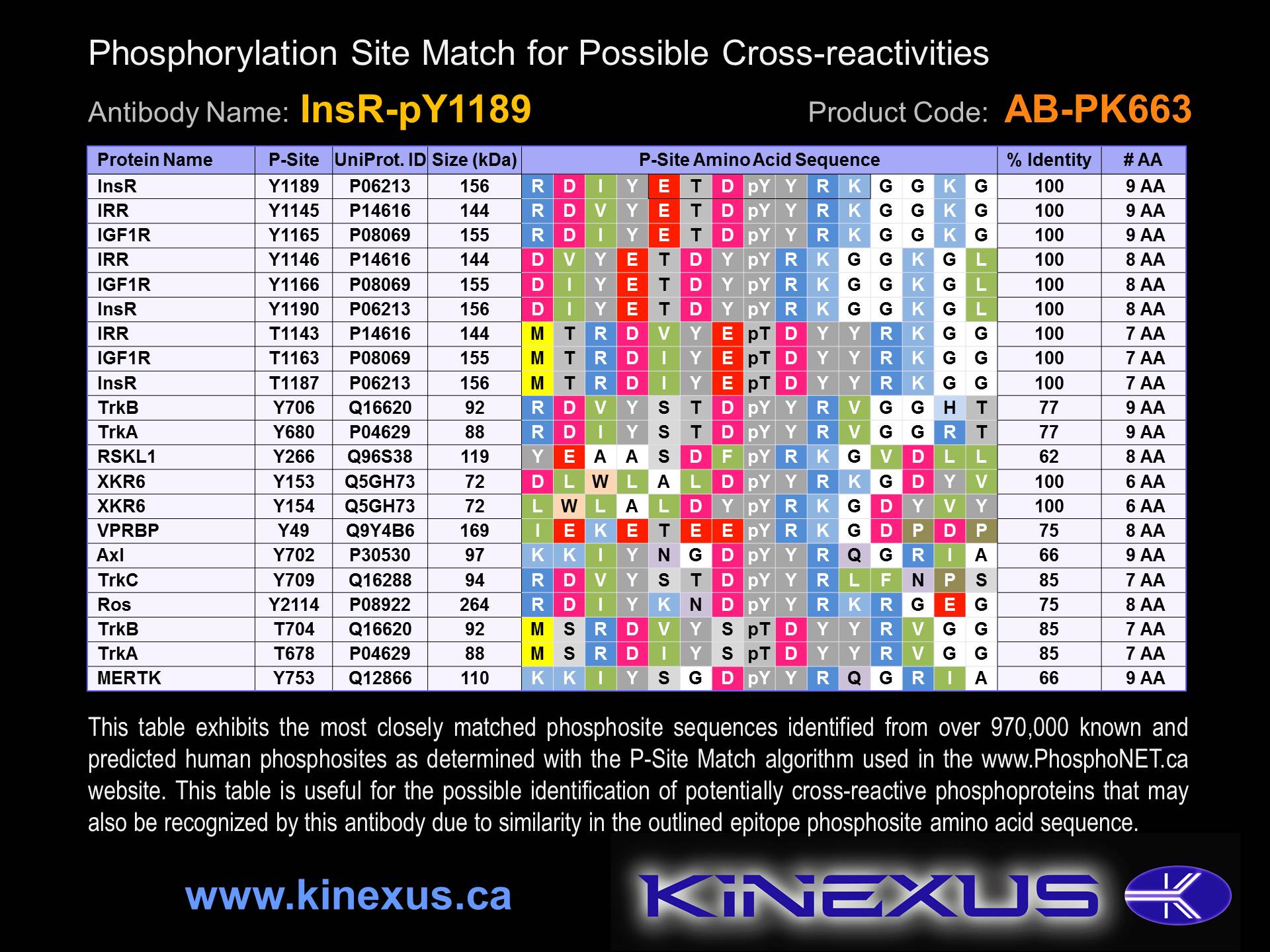Product Name: InsR-pY1189
Product Number: AB-PK663
| Size: | 25 µg | Price: | 89.00 | |
| $US |
Target Full Name: Insulin receptor
Target Alias: CD220; CD220 antigen; HHF5; Insulin receptor; IR; Kinase InsR
Product Type Specific: Protein kinase phosphosite-specific antibody
Antibody Code: PK663
Antibody Target Type: Phosphosite-specific
Antibody Phosphosite: Y1189
Protein UniProt: P06213
Protein SigNET: P06213
Antibody Type: Polyclonal
Antibody Host Species: Rabbit
Antibody Immunogen Source: Human InsR (IR) sequence peptide Cat. No.: PE-04AKM99
Target Alias: CD220; CD220 antigen; HHF5; Insulin receptor; IR; Kinase InsR
Product Type Specific: Protein kinase phosphosite-specific antibody
Antibody Code: PK663
Antibody Target Type: Phosphosite-specific
Antibody Phosphosite: Y1189
Protein UniProt: P06213
Protein SigNET: P06213
Antibody Type: Polyclonal
Antibody Host Species: Rabbit
Antibody Immunogen Source: Human InsR (IR) sequence peptide Cat. No.: PE-04AKM99
Antibody Immunogen Sequence: ETD(pY)YRK(bA)C
Antibody Immunogen Description: Corresponds to amino acid residues E1186 to K1192; In protein kinase catalytic domain activation T-loop between subdomains VII and VIII.
Antibody Immunogen Description: Corresponds to amino acid residues E1186 to K1192; In protein kinase catalytic domain activation T-loop between subdomains VII and VIII.
Production Method: The immunizing peptide was produced by solid phase synthesis on a multipep peptide synthesizer and purified by reverse-phase hplc chromatography. Purity was assessed by analytical hplc and the amino acid sequence confirmed by mass spectrometry analysis. This peptide was coupled to KLH prior to immunization into rabbits. New Zealand White rabbits were subcutaneously injected with KLH-coupled immunizing peptide every 4 weeks for 4 months. The sera from these animals was applied onto an agarose column to which the immunogen peptide was thio-linked. Antibody was eluted from the column with 0.1 M glycine, pH 2.5. Subsequently, the antibody solution was neutralized to pH 7.0 with saturated Tris.This antibody was also subject to negative purification over phosphotyrosine-agarose.
Antibody Modification: Unconjugated. Contact KInexus if you are interest in having the antibody biotinylated or coupled with fluorescent dyes.
Antibody Modification: Unconjugated. Contact KInexus if you are interest in having the antibody biotinylated or coupled with fluorescent dyes.
Antibody Concentration: 0.75 mg/ml
Storage Buffer: Phosphate buffered saline pH 7.4, 0.05% Thimerasol
Storage Conditions: For long term storage, keep frozen at -40°C or lower. Stock solution can be kept at +4°C for more than 3 months. Avoid repeated freeze-thaw cycles.
Product Use: Western blotting | Antibody microarray
Antibody Dilution Recommended: 2 µg/ml for immunoblotting
Antibody Potency: Very weak immunoreactivity of a target-sized protein by Western blotting in Jurkat cells. Very strong immunoreactivity with immunogen peptide on dot blots.
Antibody Species Reactivity: Human
Storage Buffer: Phosphate buffered saline pH 7.4, 0.05% Thimerasol
Storage Conditions: For long term storage, keep frozen at -40°C or lower. Stock solution can be kept at +4°C for more than 3 months. Avoid repeated freeze-thaw cycles.
Product Use: Western blotting | Antibody microarray
Antibody Dilution Recommended: 2 µg/ml for immunoblotting
Antibody Potency: Very weak immunoreactivity of a target-sized protein by Western blotting in Jurkat cells. Very strong immunoreactivity with immunogen peptide on dot blots.
Antibody Species Reactivity: Human
Antibody Positive Control: The observed molecular mass of the processed target protein on SDS-PAGE gels is reported to be around 90-100 kDa.
Antibody Specificity: Very high
Antibody Cross Reactivity: Almost no cross-reactivities in HEK-293 and MCF7 cells, but phenylarsine oxide (PAO) decreased a 50 kDa protein in HEK-293. A ~200 kDa cross-reactive protein was detected in Jurkat cells.
Related Product 1: InsR-pY1189 blocking peptide
Related Product 2: InsR-BCT pan-specific antibody (Cat. No.: AB-NK079-2)
Related Product 3: InsRSelectide - Insulin receptor protein kinase substrate peptide
Related Product 4: InsRSubtide - InsR protein kinase substrate peptide
Antibody Specificity: Very high
Antibody Cross Reactivity: Almost no cross-reactivities in HEK-293 and MCF7 cells, but phenylarsine oxide (PAO) decreased a 50 kDa protein in HEK-293. A ~200 kDa cross-reactive protein was detected in Jurkat cells.
Related Product 1: InsR-pY1189 blocking peptide
Related Product 2: InsR-BCT pan-specific antibody (Cat. No.: AB-NK079-2)
Related Product 3: InsRSelectide - Insulin receptor protein kinase substrate peptide
Related Product 4: InsRSubtide - InsR protein kinase substrate peptide
Related Product 5: IRS1 (979-989) KinSub - Insulin receptor substrate 1 (K979-G989, mouse) peptide; Insulin receptor substrate
Scientific Background: InsR (IR) is a protein-tyrosine kinase of the TK group and InsR family. It binds and mediates the effects of insulin. Binding of insulin to the receptor results in the downstream phosphorylation of several intracellular signalling components, including insulin receptor substrates (IRS1, 2, 3, 4), Shc, GAB1, CBL, and other intracellular signalling intermediates. Phosphorylated IRS1 recruits and activates the GRB2/SOS complex, which in turn leads to the activation of the Ras/Raf/MAP2K/MAPK signalling pathway. This pathway is mainly involved in the regulation of cell growth, survival, and cellular differentiation resulting from insulin signalling. Insulin binds to InsR to trigger autophosphorylation at many sites, including Y999, S1001, Y1185, Y1189, Y1190, S1332, S1333, Y1355, Y1361 and T1375, which increases its phosphotransferase activity. Protein interactions are induced with phosphorylation of Y999 (with SOCS3) and Y1185, Y1189 and Y1190 (with IRS2 and PTP1B). Phosphorylation of Y992 and Y1011 inhibits the phosphotransferase activity of InsR. Binding of insulin to the InsR stimulates glucose uptake. Insulin receptor signalling helps to maintain fuel homeostasis and prevent diabetes. InsR signalling also increases the regeneration of adult beta-cells and the central control of nutrient homeostasis. InsR has also been linked with the development of insulin resistance, familial hyperinsulinemic hypoglycemia Type 5 (HHF5), and gastric adenocarcinomas. InsR appears to be an oncoprotein (OP). Over activation of the insulin receptor signalling pathway has been linked to the development of several cancer types, including breast cancer. In addition, elevated InsR expression in breast cancer is correlated with poor patient survival.
Figure 1. Epitope mapping of InsR-pY1189 antibody with similar phosphopeptides on dot blots.
Figure 2. Identification of phosphosites related to InsR-pY1189.
© Kinexus Bioinformatics Corporation 2017



